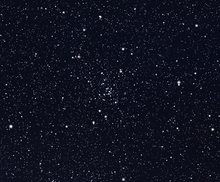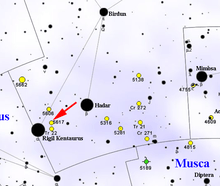NGC 5617
NGC 5617 is an open cluster in the constellation Centaurus. NGC 5617 forms a binary open cluster with Trumpler 22. It lies one degree west-northwest of Alpha Centauri.
| NGC 5617 | |
|---|---|
 NGC 5617 (taken with Stellarium) | |
| Observation data (J2000 epoch) | |
| Constellation | Centaurus |
| Right ascension | 14h 29m 44s[1] |
| Declination | −60° 42′ 42″[1] |
| Distance | 5,770 ly (1,769 pc[2]) |
| Apparent magnitude (V) | 6.3[1] |
| Apparent dimensions (V) | 10' |
| Physical characteristics | |
| Estimated age | 82 Myr[3] |
| Other designations | Cr 282, Mel 125 |
Observation history

It was discovered by James Dunlop in 1826. He described it on May 8, 1826 as "a cluster of small stars of mixed magnitudes, considerably congregated towards the centre, 4' or 5' in diametre" and added it to his catalog as number 302. John Herschel described as "Class IV object, very rich; irregularly round; pretty much compressed in the middle but scattered at borders; 15'; there are three stars of 10th magnitude, 5 or 6 stars of 11th magnitude; the rest below 11th" and added it to General Catalogue as No. 3570. In the New General Catalogue it is described as "large (10'), richer in stars to the west (about 80 total), with a compressed middle. It contains stars of magnitude 8 and fainter."[4]
Characteristics
NGC 5617 is located nearly 2 kpc (6.500 light years) away from Earth, at the further border of Carina-Sagittarius arm.[5] Various photometric studies have yield different results concerning the age and the distance of the cluster; Moffat & Vogt (1975) studied and calculated a distance of 1.34 kpc from the Sun, Haug (1978) found its distance to be 1.82 kpc, a CCD photometry by Kjeldsen & Frandsen (1991) found the distance to be 2.05 ± 0.2 kpc and the age 70 Myr and Carra & Munari (2004) used BVI photometry to obtain reddening EB−V= 0.48 ± 0.05, age of 80 Myr, and a distance of 2.0 ± 0.3 kpc.[6] De Silva et al. (2015) calculated its distance at 2.1 ± 0.3 kpc.[7]
There are 175 probable member stars within the angular radius of the cluster and 65 within the central part of the cluster. The tidal radius of the cluster is 7.4 - 10.2 parsecs (24 - 33 light years) and represents the average outer limit of NGC 5617, beyond which a star is unlikely to remain gravitationally bound to the cluster core.[2] One blue straggler is possible member of the cluster.[5] Possible members of the cluster are also a delta Scuti variable, a gamma Doradus variable and eclipsing variable stars.[8]
Relation with Trumpler 22
NGC 5617 appears to be gravitationally bound to Trumpler 22.[9] The two clusters share similar radial velocities (-38.63 ± 2.25 km/s for NGC 5617 and -38.46 ± 2.08 km/s for Trumpler 22), mean metallicity (-0.18 ± 0.02 for NGC 5617 and-0.17 ± 0.04 for Trumpler 22), similar abundances across various elements, and have similar age, forming a primordial binary cluster pair.[7] Their orbits were initially almost circular and their separation less than 20 pc.[9]
References
- "NGC 5617". SIMBAD. Centre de données astronomiques de Strasbourg. Retrieved 2015-06-19.
- Kharchenko, N. V.; Piskunov, A. E.; Schilbach, E.; Röser, S.; Scholz, R.-D. (3 October 2013). "Global survey of star clusters in the Milky Way". Astronomy & Astrophysics. 558: A53. arXiv:1308.5822. Bibcode:2013A&A...558A..53K. doi:10.1051/0004-6361/201322302.
- "WEBDA: page for open cluster NGC 5617". www.univie.ac.at.
- O'Meara, Stephen James (2013). Deep-Sky Companions: Southern Gems. Cambridge University Press. p. 269. Bibcode:2013dcsg.book.....O. ISBN 9781107015012.
- Orsatti, A. M.; Feinstein, C.; Vergne, M. M.; Martínez, R. E.; Vega, E. I. (30 April 2010). "Polarimetry of an intermediate-age open cluster: NGC 5617". Astronomy and Astrophysics. 513: A75. arXiv:1003.2985. Bibcode:2010A&A...513A..75O. doi:10.1051/0004-6361/200913171.
- Carraro, G.; Munari, U. (11 January 2004). "A multicolour CCD photometric study of the open clusters NGC 2866, Pismis 19, Westerlund 2, ESO96-SC04, NGC 5617 and NGC 6204". Monthly Notices of the Royal Astronomical Society. 347 (2): 625–631. arXiv:astro-ph/0309720. Bibcode:2004MNRAS.347..625C. doi:10.1111/j.1365-2966.2004.07244.x.
- De Silva, G. M.; Carraro, G.; D'Orazi, V.; Efremova, V.; Macpherson, H.; Martell, S.; Rizzo, L. (12 August 2015). "Binary open clusters in the Milky Way: photometric and spectroscopic analysis of NGC 5617 and Trumpler 22". Monthly Notices of the Royal Astronomical Society. 453 (1): 106–112. arXiv:1507.03230. Bibcode:2015MNRAS.453..106D. doi:10.1093/mnras/stv1583.
- Carrier, F.; Saesen, S.; Cherix, M.; Bourban, G.; Burki, G.; Debosscher, J.; Debruyne, D.; Gruyters, P.; Sarro, L. M.; Spano, M.; Weber, L. (1 July 2009). "Photometric campaign on massive stars in the open cluster NGC 5617". Communications in Asteroseismology. 158: 199. arXiv:0901.0627. Bibcode:2009CoAst.158..199C. ISSN 1021-2043.
- de la Fuente Marcos, R.; de la Fuente Marcos, C. (10 August 2010). "The evolution of primordial binary open star clusters: mergers, shredded secondaries, and separated twins". The Astrophysical Journal. 719 (1): 104–118. arXiv:1006.5200. Bibcode:2010ApJ...719..104D. doi:10.1088/0004-637X/719/1/104.
External links
| Wikimedia Commons has media related to NGC 5617. |
- NGC 5617 on WikiSky: DSS2, SDSS, GALEX, IRAS, Hydrogen α, X-Ray, Astrophoto, Sky Map, Articles and images